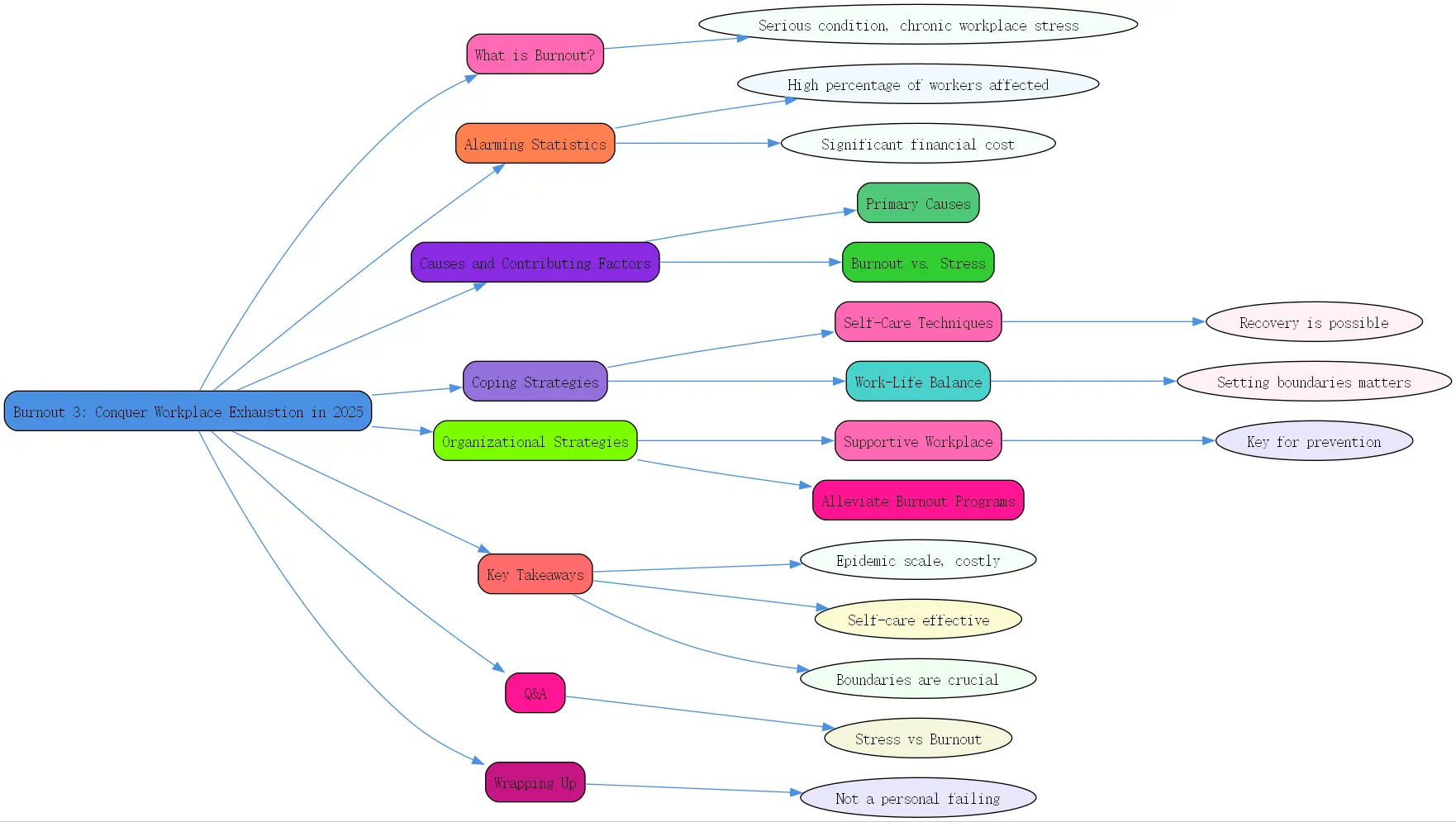In today’s relentless work culture, burnout has become a widespread challenge, impacting employees across industries. As we move into 2025, understanding burnout—especially its workplace dominance—is more critical than ever. This article explores the essence of burnout, its startling prevalence, and practical ways to tackle it. Whether you’re an individual feeling the strain or an organization aiming to support your team, we’ve got you covered with insights and strategies to conquer workplace exhaustion.
What is Burnout? (Burnout O Que É)

Burnout isn’t just a buzzword—it’s a serious condition recognized by the World Health Organization as the result of chronic workplace stress that hasn’t been managed effectively. Unlike a fleeting bad day, burnout creeps in over time, leaving you physically fatigued, emotionally drained, and detached from tasks you once cared about. It’s that overwhelming sense of “I can’t keep going” that lingers far beyond a single stressful moment.
The symptoms are hard to ignore: persistent exhaustion that sleep can’t fix, a cynical attitude toward work, and a lack of motivation that makes even small wins feel meaningless. For many, burnout sneaks up unnoticed until it’s fully taken hold. Understanding it—burnout o que é, or “what is burnout” in Portuguese—starts with recognizing it’s not your fault. It’s a response to prolonged pressure, often rooted in workplace dynamics beyond your control.
Why does this matter? Because burnout doesn’t just stay at the office. It spills into your personal life, affecting relationships, health, and happiness. Left unchecked, it can lead to anxiety or worse. That’s why spotting the early signs—like those initial flickers of burnout 1—is key to stopping it before it deepens into something harder to shake.
The Alarming Statistics of Burnout (Burnout 1)
The numbers paint a grim picture. In 2023, a staggering 89% of workers reported experiencing burnout, a trend that’s likely to persist into 2025 without intervention. Even remote work, often touted as a flexibility perk, isn’t a shield—86% of full-time remote employees have felt burnout’s grip. These stats reveal a truth: burnout doesn’t discriminate by work setting.
The financial toll is just as shocking. Workplace stress, with burnout as a major driver, costs the U.S. economy around $300 billion annually. That’s billions lost to absenteeism, reduced productivity, and healthcare expenses. For businesses, burnout isn’t just a people problem—it’s a bottom-line issue. High turnover and disengaged teams are the hidden costs companies can’t afford to ignore.
For individuals, these figures might feel personal. If you’re nodding along, you’re not alone—burnout 1, or the first signs of exhaustion, is more common than ever. Recognizing its scale is the first step to tackling it, both for yourself and the broader workforce. The data screams urgency: we need solutions, and we need them now.
Causes and Contributing Factors to Burnout
Primary Causes of Burnout
What fuels burnout? At the top of the list is excessive workload—a relentless pile of tasks that leaves no room to breathe. Picture this: deadlines stacking up, emails flooding in, and no end in sight. It’s the number one culprit, but it’s not alone. A lack of control over your work—like being micromanaged or sidelined—adds to the strain. So does insufficient support from colleagues or bosses, or a shortage of resources to get the job done.
These aren’t just personal gripes; they’re systemic issues. Workplaces that demand too much without offering balance create a breeding ground for burnout 3—a term we’ll use to highlight its pervasive, overwhelming nature. It’s not about laziness or weakness. It’s about environments that push people past their limits, often without realizing the damage until it’s done.
Burnout vs. Stress: Understanding the Difference
Stress and burnout get tangled up in conversation, but they’re not twins. Stress is that immediate knot in your stomach before a big meeting—intense, but usually short-lived. Burnout, though, is a slow burn. It’s the result of chronic stressors piling up, turning temporary pressure into a prolonged state of exhaustion. Think of stress as a sprint; burnout is a marathon you didn’t sign up for.
Here’s the kicker: stress often tags along with burnout, but it’s not the whole story. You can be stressed without being burned out—say, during a busy week that ends with relief. Burnout, however, lingers. It’s that heavy, unshakable feeling that no weekend can cure. Knowing the difference helps you catch burnout t (types or traits of burnout) early and act before it takes over.

Effective Strategies for Coping with Burnout (Burnout T)
Self-Care Techniques for Burnout Recovery (7 3 Burnout)
Beating burnout starts with you, even if it feels impossible when you’re running on empty. Self-care isn’t a luxury—it’s a lifeline. Start small: talk to someone you trust. A friend, family member, or therapist can help you unpack the weight on your shoulders. Letting those thoughts out can lighten the load more than you’d expect.
Journaling’s another gem. Scribbling down your frustrations or fears—call it your 7 3 burnout release—can clear mental fog and ease emotional exhaustion. Not sure where to start? Our therapy blogging blog at BrainTalking has tips to get you going. These steps aren’t magic fixes, but they’re a solid foundation for reclaiming your energy.
Don’t underestimate the power of rest, either. When you’re burned out, even basic tasks feel like climbing a mountain. Give yourself permission to pause. Whether it’s a nap or a quiet evening, these moments recharge you bit by bit. Recovery isn’t instant, but consistent self-care builds resilience against burnout’s return.
Setting Boundaries and Promoting Work-Life Balance
Boundaries are your burnout shield. If you’re a people-pleaser, saying “no” might feel foreign—but it’s liberating. Focus on your core job duties and let the extras slide when you’re stretched thin. This isn’t slacking; it’s protecting your mental space so you can thrive at work and beyond.
Outside the office, lean into what lights you up. Hobbies like painting or gaming, a brisk walk, or a gym session with a buddy—these aren’t just distractions; they’re balance-builders. A healthy lifestyle seals the deal: eat well, drink water, and aim for seven hours of sleep. Struggling with the anxiety that often tags along? Check out 3 realistic ways to manage anxiety from BrainTalking for practical relief.
Work-life balance isn’t a cliché—it’s a necessity. When work consumes everything, burnout 3 creeps in, sapping your joy. By carving out time for yourself, you’re not just surviving; you’re taking back control. It’s about small, intentional shifts that add up to big wins.
Organizational Strategies for Addressing Employee Burnout
Creating a Supportive Workplace Culture
Organizations aren’t off the hook—burnout’s too big for individuals to tackle alone. A supportive culture starts with open communication. Employees need a safe space to voice struggles without judgment. Managers, listen up: hearing your team and acting on their feedback builds trust and nips burnout in the bud.
Spotting burnout hotspots is step one. Is a team drowning in deadlines? Are resources stretched thin? Recognizing these red flags shows employees you’re serious about their well-being. It’s not about coddling—it’s about fostering an environment where people can thrive, not just survive. A workplace that listens is a workplace that wins.
Implementing Programs to Alleviate Burnout
Action beats talk every time. Offer mental health days—real, guilt-free breaks for employees to recharge. Too many companies (21%, per recent data) skip this, leaving workers to fend for themselves. That’s a mistake. A day off can reset motivation and mood, cutting burnout’s grip.
Go further with mental health programs—counseling access, stress workshops, or wellness perks. These aren’t fluff; they’re investments. When employees see you’re committed, they’re more likely to stick around and stay engaged. BrainTalking’s research backs this: proactive organizations see lower turnover and higher morale. Burnout’s a team fight—equip your people to win it.
Key Takeaways
- Burnout’s epidemic scale: Nearly 90% of workers faced it in 2023, costing the U.S. $300 billion yearly.
- Self-care works: Talk it out, journal, and rest to recover from burnout’s toll.
- Boundaries matter: Say “no” and prioritize balance to keep burnout at bay.
- Organizations step up: Communication and mental health programs are game-changers.
Q&A Section
Q: How can I tell if I’m stressed or burned out?
A: Great question! Stress hits fast—think racing heart before a deadline. It’s intense but fades with rest. Burnout’s slower, deeper—a constant exhaustion that lingers despite breaks, paired with apathy toward work. Stress might leave you frazzled but hopeful; burnout feels hopeless. Track your feelings: if weeks pass and you’re still drained, it’s likely burnout. Act early—stress is manageable, but burnout needs bigger fixes like boundaries or support.

Wrapping Up





